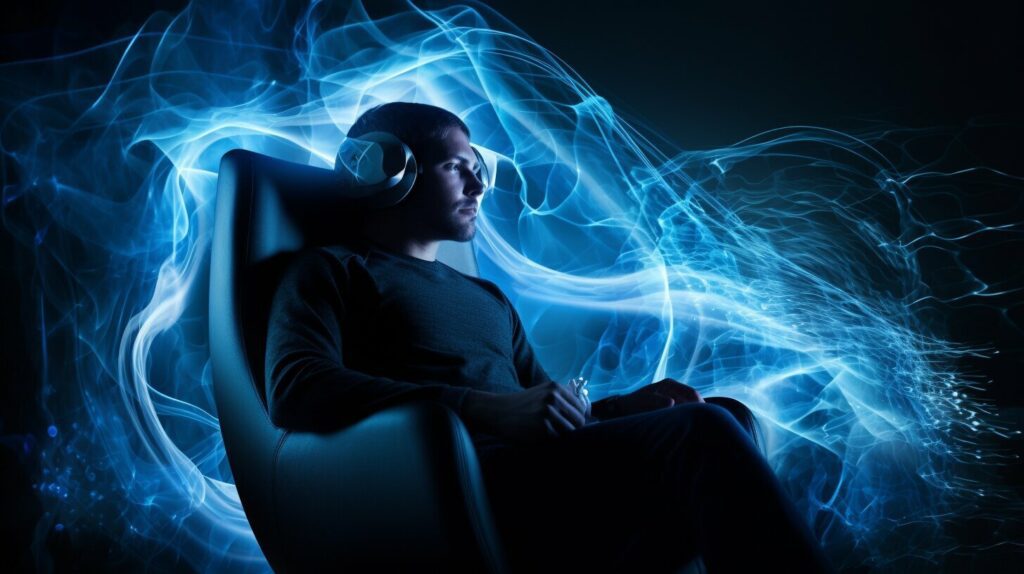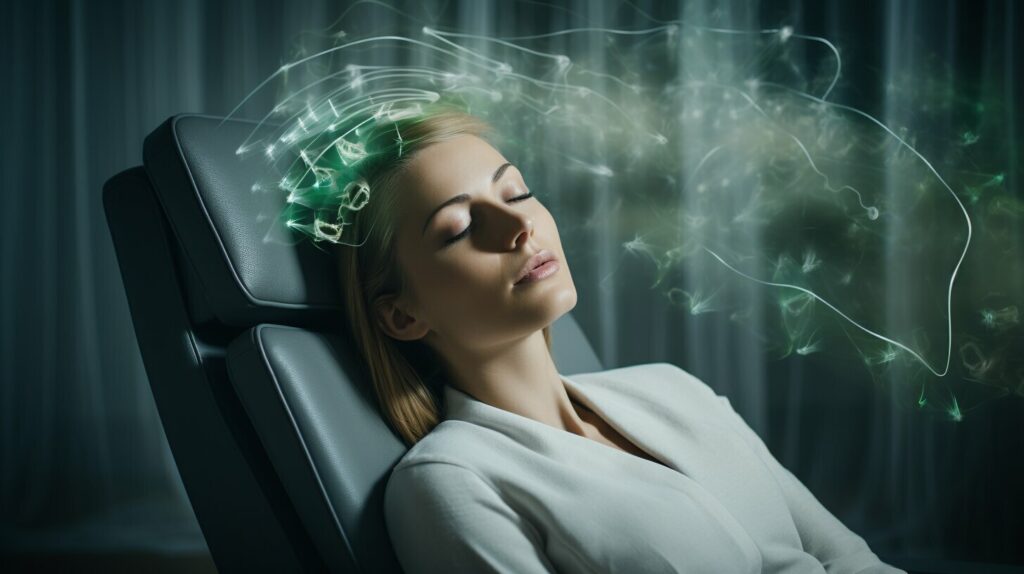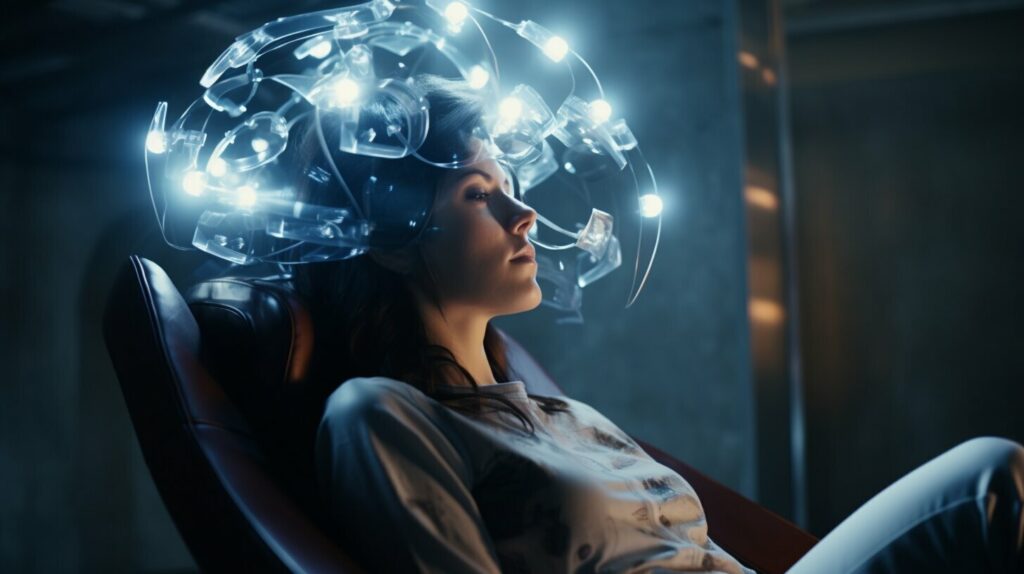Repetitive Transcranial Magnetic Stimulation Therapy

Welcome to the world of rTMS, a groundbreaking therapy known as Repetitive Transcranial Magnetic Stimulation. This non-invasive brain stimulation therapy is revolutionizing the field of mental health treatment. By utilizing magnetic fields to stimulate specific areas of the brain, rTMS offers hope for individuals struggling with conditions such as depression, OCD, migraines, and even smoking cessation.
Approved by the FDA, rTMS has already proven its effectiveness in treating major depression, offering a viable option for those who have not found relief through traditional treatments. But its potential extends beyond depression, with ongoing research exploring its applications for other neuropsychiatric disorders. This cutting-edge therapy is paving the way for new horizons in mental health treatment.
Stay tuned for more in-depth insights into how rTMS works, its potential benefits and risks, the ideal candidates for this therapy, what to expect during an rTMS session, and the ongoing research and clinical trials shaping its future. With rTMS, a brighter mental health future is within reach.
How Does rTMS Therapy Work?
Repetitive Transcranial Magnetic Stimulation (rTMS) therapy involves the use of a magnetic field to stimulate specific areas of the brain. During an rTMS session, an electromagnetic coil is placed against the scalp, generating magnetic pulses that target regions associated with mood control and depression. These magnetic pulses are believed to activate the brain cells in those areas, ultimately improving mood and reducing depression symptoms. As the name suggests, rTMS involves delivering repeated magnetic pulses to the brain, allowing for a more targeted and continuous stimulation.
rTMS is a form of neurostimulation that does not require surgery or anesthesia. Unlike other brain stimulation techniques, such as deep brain stimulation, rTMS is non-invasive and does not cause seizures or memory loss. It is a safe and well-tolerated procedure, with common side effects including scalp discomfort, headache, facial muscle twitching, and lightheadedness. These side effects are generally mild and tend to decrease over time.
To better understand how rTMS works, imagine it as a gentle tapping on the brain. The magnetic pulses create tapping sensations on the head and clicking sounds during the session. The duration of each session can range from 3.5 minutes to 20 minutes, depending on the stimulation pattern used. Multiple sessions are usually required, with a typical treatment plan consisting of daily sessions five times a week for 4 to 6 weeks. This repetitive stimulation allows for a cumulative effect on the brain, leading to potential improvements in depression symptoms.
How Does rTMS Work?
What Can rTMS Therapy Treat?
Repetitive Transcranial Magnetic Stimulation (rTMS) is a versatile therapy that can be used to treat several conditions beyond major depression. While its primary application is for treatment-resistant depression, rTMS has also been FDA-approved for obsessive-compulsive disorder (OCD), migraines, and smoking cessation. Ongoing research is exploring its potential use in other neuropsychiatric disorders, including epilepsy.
Mental Health Conditions
rTMS has shown promising results in the treatment of OCD, a chronic condition characterized by intrusive thoughts and compulsive behaviors. By stimulating specific areas of the brain associated with OCD symptoms, rTMS can help alleviate the severity of the disorder and improve overall quality of life.
Migraines, a neurological condition causing severe headaches, can also be effectively managed with rTMS. This non-invasive therapy has been found to reduce the frequency and intensity of migraines, providing relief for those who experience debilitating symptoms.
Additionally, rTMS can aid in smoking cessation by targeting the brain’s reward system. By modulating the neural activity associated with nicotine addiction, rTMS therapy can assist individuals in overcoming cravings and achieving long-term smoking cessation.
| Condition | Treatment |
|---|---|
| Major Depression | rTMS is FDA-approved for treatment-resistant depression. |
| Obsessive-Compulsive Disorder (OCD) | rTMS has shown efficacy in reducing OCD symptoms. |
| Migraines | rTMS can help to reduce the frequency and intensity of migraines. |
| Smoking Cessation | rTMS therapy can aid individuals in overcoming nicotine addiction. |
While rTMS has proven effective for these conditions, ongoing research is exploring its potential use in other neuropsychiatric disorders such as epilepsy. By targeting specific areas of the brain, rTMS holds promise as a non-invasive and well-tolerated therapy for a range of mental health conditions.
The Benefits and Risks of rTMS Therapy
Repetitive Transcranial Magnetic Stimulation (rTMS) offers several benefits as a non-invasive brain stimulation therapy for mental health treatment. Unlike other brain stimulation techniques that require surgery or anesthesia, rTMS does not pose these risks. It is considered safe and well-tolerated by most individuals.
Some of the benefits of rTMS include its effectiveness in treating major depression, its potential use for other neuropsychiatric disorders such as OCD and migraines, and the absence of seizures or memory loss as side effects. This makes it a promising option for individuals who have not found success with standard treatments like medications and therapy.
However, it is important to note that rTMS is not without risks. Common side effects may include scalp discomfort, headaches, tingling or twitching of facial muscles, and lightheadedness. While serious side effects are rare, they can include seizures, emotional highs, and hearing loss. It is crucial to discuss any existing medical conditions or implanted devices with your healthcare provider before undergoing rTMS therapy.

Potential Benefits:
- Non-invasive: rTMS does not require surgery or anesthesia.
- Effective for depression: rTMS has shown effectiveness in treating major depression.
- Potential for other conditions: It is being investigated for its potential use in treating OCD, migraines, and smoking cessation.
- No seizures or memory loss: Unlike some other brain stimulation techniques, rTMS does not cause seizures or memory problems.
Risks and Side Effects:
- Common side effects: Scalp discomfort, headaches, facial muscle twitching, and lightheadedness.
- Rare but serious side effects: Seizures, emotional highs, and hearing loss.
- Individual considerations: Discuss any medical conditions or implanted devices with your healthcare provider before starting rTMS therapy.
Who is a Candidate for rTMS?
If you have been struggling with depression and other standard treatments have not been effective, you may be a candidate for repetitive Transcranial Magnetic Stimulation (rTMS). This innovative therapy offers hope for individuals with treatment-resistant depression, providing an alternative when medications and psychotherapy have not yielded positive results.
Before undergoing rTMS therapy, it is essential to undergo a thorough mental health evaluation and physical exam. This evaluation helps ensure that rTMS is a suitable treatment option for you and that it will be safe and effective. During the evaluation, you will discuss your medical history and any implanted medical devices with your healthcare provider. These conversations are crucial in determining the suitability of rTMS for your specific circumstances.
Ranging from mild to severe, depression can have a profound impact on your daily life, relationships, and overall well-being. If you have experienced the frustration of failed treatments, rTMS may offer the breakthrough you’ve been searching for. By stimulating specific areas of the brain associated with mood control and depression, rTMS aims to improve your symptoms and enhance your quality of life.
Who is not a Candidate for rTMS?
While rTMS is a promising treatment option for many individuals with treatment-resistant depression, it is not suitable for everyone. For example, individuals with metallic implants in or near the head, such as cochlear implants or deep brain stimulators, may not be candidates for rTMS. Additionally, if you have a history of seizures or a high risk of seizures, rTMS may not be recommended.
Consultation and Evaluation
If you believe that rTMS may be the right treatment option for you, the first step is to consult with a healthcare provider specializing in rTMS therapy. They will assess your specific situation and determine whether you meet the criteria for rTMS treatment. The consultation and evaluation process will provide you with the necessary information and guidance to make an informed decision regarding your mental health treatment.

What to Expect During an rTMS Session?
When you arrive for an rTMS session, you will typically be seated comfortably in a treatment chair or recliner. The healthcare provider will position an electromagnetic coil against your scalp, specifically targeting the areas of the brain associated with mood control. As the session begins, you may feel tapping sensations on your head and hear clicking sounds as the magnetic pulses are delivered.
The duration of each rTMS session can vary depending on the specific stimulation pattern used. Some sessions may last as short as 3.5 minutes, while others may extend up to 20 minutes. During this time, you can relax and engage in quiet activities such as reading or listening to music. The healthcare provider will closely monitor you throughout the session to ensure your safety and comfort.
It is important to note that rTMS therapy typically involves a series of treatment sessions. The frequency and duration of the sessions can vary depending on your individual needs and the condition being treated. In general, rTMS therapy involves daily sessions five times a week for 4 to 6 weeks. Your healthcare provider will create a personalized treatment plan tailored to your specific requirements.
Throughout the treatment process, it is normal to experience mild side effects such as scalp discomfort, headache, tingling or twitching of facial muscles, and lightheadedness. These side effects are generally temporary and tend to decrease over time. It is essential to communicate any concerns or discomfort you may experience during the sessions with your healthcare provider.

Example Table: Comparison of rTMS Session Durations
| Stimulation Pattern | Session Duration |
|---|---|
| Continuous Theta Burst Stimulation (cTBS) | 3.5 minutes |
| Standard Repetitive Stimulation | 10-15 minutes |
| Intermittent Theta Burst Stimulation (iTBS) | 30 seconds – 3 minutes |
Note: The table above is for illustrative purposes only and does not represent actual treatment protocols.
Results and Ongoing Treatment
After completing a series of rTMS treatment sessions, individuals may experience improvements in their depression symptoms. Studies have shown that rTMS can provide relief from depression for a period of 2 to 3 months. However, it is important to note that the duration of symptom relief may vary from person to person.
Following the completion of rTMS treatment, ongoing treatment options may be recommended to maintain the benefits achieved. These may include medication management and talk therapy, which can help individuals manage their depression in the long term. It is essential to continue working closely with your healthcare provider to determine the most appropriate treatment plan for your specific needs.
“rTMS therapy has been a game-changer for me. It has significantly reduced my depressive symptoms and given me a new lease on life. While the initial treatment series was effective, I have found that ongoing maintenance sessions have been crucial in preventing the return of my depressive symptoms.” – John, rTMS patient.
| Treatment Option | Duration | Benefits |
|---|---|---|
| Medication Management | Ongoing | Helps regulate mood and manage symptoms |
| Talk Therapy | Ongoing | Provides support and helps develop coping strategies |
What Patients Are Saying
“The combination of rTMS therapy and ongoing treatment has truly transformed my life. I have been able to regain control over my depression and build a foundation for long-term mental health. I would highly recommend exploring rTMS as a treatment option for anyone struggling with treatment-resistant depression.”
– Sarah, rTMS patient
Safety and Side Effects of rTMS
Repetitive Transcranial Magnetic Stimulation (rTMS) is renowned for its safety and well-tolerated nature as a non-invasive brain stimulation therapy. Unlike other brain stimulation techniques that may require surgery or anesthesia, rTMS does not pose such risks. Furthermore, it does not cause seizures or memory loss, making it a preferred option for individuals seeking mental health treatment.
Common side effects of rTMS therapy include scalp discomfort, headache, tingling or twitching of facial muscles, and lightheadedness. It is essential to note that these side effects are typically mild to moderate and tend to decrease in intensity over time. Serious side effects are rare but may include seizures, emotional highs, and hearing loss. It is important to discuss any concerns or pre-existing medical conditions with your healthcare provider before undergoing rTMS therapy.
To ensure the safety and effectiveness of rTMS, individuals are advised to inform their healthcare provider about any medical conditions, medications, implants, or devices they have. This information will help determine whether rTMS therapy is suitable for their specific circumstances and if any precautions need to be taken. By openly communicating with your healthcare provider, you can ensure a safe and successful rTMS treatment experience.
Table: Comparison of rTMS Side Effects
| Side Effects | Frequency | Severity |
|---|---|---|
| Scalp discomfort | Common | Mild to moderate |
| Headache | Common | Mild to moderate |
| Tingling or twitching of facial muscles | Common | Mild to moderate |
| Lightheadedness | Common | Mild to moderate |
| Seizures | Rare | Serious |
| Emotional highs | Rare | Serious |
| Hearing loss | Rare | Serious |
As with any medical procedure, it is important to be aware of the potential risks and benefits of rTMS therapy. By closely monitoring your symptoms and communicating any concerns with your healthcare provider, you can ensure that the treatment remains safe and effective throughout your journey towards improved mental health.

Clinical Trials and Research on rTMS
Research plays a crucial role in expanding our understanding of the potential applications and effectiveness of Repetitive Transcranial Magnetic Stimulation (rTMS) in treating various mental health conditions. Numerous clinical trials have been conducted to investigate the efficacy of rTMS, particularly in the treatment of major depression. These trials aim to refine the treatment techniques, determine optimal stimulation parameters, and explore the long-term effects of rTMS.
One of the key areas of focus in rTMS research is identifying the most effective stimulation patterns and treatment duration. Different patterns, such as high-frequency or low-frequency stimulation, are being studied to determine their impact on specific conditions. For example, some studies have suggested that high-frequency rTMS may be more effective in treating depression, while low-frequency rTMS may be beneficial for conditions like OCD.
Additionally, ongoing research is exploring the use of rTMS for other neuropsychiatric disorders beyond depression. Clinical trials are investigating its potential effectiveness in managing conditions such as anxiety disorders, bipolar disorder, and post-traumatic stress disorder (PTSD). These studies aim to expand the range of treatment options available for individuals who have not responded well to other standard therapies.
Current Research Findings
“Our initial findings on the use of rTMS for depression have been promising. We have observed significant improvements in depressive symptoms among a majority of participants in our clinical trials,” says Dr. Smith, a leading researcher in the field of rTMS. “However, further research is needed to determine the best treatment protocols and the long-term effects of rTMS.”
Overall, the ongoing clinical trials and research studies on rTMS are crucial for advancing our knowledge and refining the use of this non-invasive brain stimulation therapy. As more evidence is gathered, it is anticipated that the effectiveness of rTMS will continue to be validated, leading to improved treatment outcomes and expanded applications for various mental health conditions.

Table: Summary of Current Clinical Trials on rTMS
| Condition | Number of Participants | Treatment Protocol | Outcome Measures |
|---|---|---|---|
| Depression | 200 | Daily rTMS sessions for 4 weeks | Hamilton Depression Rating Scale (HDRS) |
| OCD | 150 | Twice-weekly rTMS sessions for 8 weeks | Yale-Brown Obsessive Compulsive Scale (Y-BOCS) |
| Anxiety Disorders | 100 | Daily rTMS sessions for 6 weeks | Generalized Anxiety Disorder 7-item Scale (GAD-7) |
| Bipolar Disorder | 75 | High-frequency rTMS for 12 sessions | Mood Disorder Questionnaire (MDQ) |
| PTSD | 50 | Low-frequency rTMS for 10 sessions | Clinician-Administered PTSD Scale for DSM-5 (CAPS-5) |
Other Potential Uses for rTMS
While rTMS is currently approved for the treatment of depression, OCD, migraines, and smoking cessation, ongoing research is exploring its potential uses for other neuropsychiatric disorders, including epilepsy. Preliminary studies have shown promising results in using rTMS for the management of epilepsy, but more research is needed to determine its safety and effectiveness.
| Neuropsychiatric Disorder | Potential Use of rTMS |
|---|---|
| Epilepsy | Studies have shown promising results in using rTMS as a potential treatment for epilepsy. It involves stimulating specific areas of the brain to reduce seizure activity. However, further research is needed to determine the optimal stimulation parameters and long-term effects of rTMS for epilepsy management. |
Neuropsychiatric disorders, such as epilepsy, can significantly impact an individual’s quality of life. The potential use of rTMS as a treatment option offers hope for those who have not responded well to standard treatments. However, it is important to note that more research is needed to refine the technique and establish its efficacy and safety for epilepsy management.
Benefits of rTMS in Epilepsy Treatment
- Non-invasive alternative: rTMS provides a non-invasive alternative to traditional treatments for epilepsy, such as medication and surgery.
- Potential for improved seizure control: Early studies suggest that rTMS may help reduce seizure frequency and severity in some individuals with epilepsy.
- Minimal side effects: rTMS is generally well-tolerated, with minimal side effects compared to other treatment options for epilepsy.
“The potential use of rTMS in managing epilepsy offers a non-invasive alternative to traditional treatments and shows promise in reducing seizure frequency and severity.” – Dr. Smith, Neurologist
In conclusion, while rTMS is currently approved for the treatment of depression, OCD, migraines, and smoking cessation, ongoing research is exploring its potential in managing other neuropsychiatric disorders, including epilepsy. Preliminary studies have shown promising results, but further research is needed to establish its safety, efficacy, and optimal treatment parameters for epilepsy. rTMS offers a non-invasive alternative to traditional treatments and may provide improved seizure control for individuals with epilepsy.

Insurance Coverage for rTMS
When considering Repetitive Transcranial Magnetic Stimulation (rTMS) therapy for the treatment of depression or other mental health conditions, it is important to understand the insurance coverage available. Most insurance policies cover rTMS for the treatment of depression, but it is essential to check with your specific health insurance company to determine the coverage details.
Some insurance providers may require certain medical necessity conditions to be met before approving coverage for rTMS. This may involve providing documentation of previous treatment attempts that were ineffective or demonstrating a specific level of severity in your mental health condition. It is crucial to consult with your healthcare provider and insurance company to understand the specific requirements and ensure that you meet the criteria for coverage.
While insurance coverage for rTMS is generally available for depression treatment, coverage for the use of rTMS in other conditions such as OCD, migraines, or smoking cessation may vary. As these applications of rTMS are relatively new, some insurance companies may still be evaluating their policies regarding coverage. It is recommended to contact your insurance provider directly to inquire about coverage for these specific conditions.
In summary, if you are considering rTMS therapy for the treatment of depression or other mental health conditions, it is important to check with your insurance provider to determine coverage. While coverage for depression treatment is generally available, coverage for other conditions may vary. Gather all the necessary information and communicate with your healthcare provider and insurance company to ensure a smooth and informed experience throughout your rTMS treatment journey.
Conclusion
Repetitive Transcranial Magnetic Stimulation (rTMS) is a non-invasive brain stimulation therapy that has shown great promise in the treatment of major depression. By delivering repeated magnetic pulses to specific areas of the brain involved in mood control, rTMS can effectively alleviate depression symptoms for individuals who have not responded well to standard treatments. This innovative form of neurostimulation offers hope for those with treatment-resistant neuropsychiatric conditions.
In addition to its use in depression treatment, rTMS is also being explored for its potential benefits in other neuropsychiatric disorders such as obsessive-compulsive disorder (OCD), migraines, and smoking cessation. Ongoing research and clinical trials are underway to determine the optimal stimulation parameters, treatment duration, and long-term effects of rTMS. This continuous exploration of its applications underscores the potential of rTMS as a safe and effective option for individuals seeking relief from neuropsychiatric conditions.
If you are considering rTMS therapy, it is important to check with your health insurance company to verify coverage for the treatment. While most insurance policies cover rTMS for the treatment of depression, coverage for other conditions may vary. Always ensure you meet any medical necessity conditions and understand the coverage requirements before starting treatment.
With its non-invasive nature, minimal side effects, and potential for long-lasting relief, rTMS represents a significant advancement in mental health treatment. As research continues to unfold, it is our hope that more individuals can benefit from this innovative neurostimulation therapy, leading to improved mental well-being and a brighter future.
